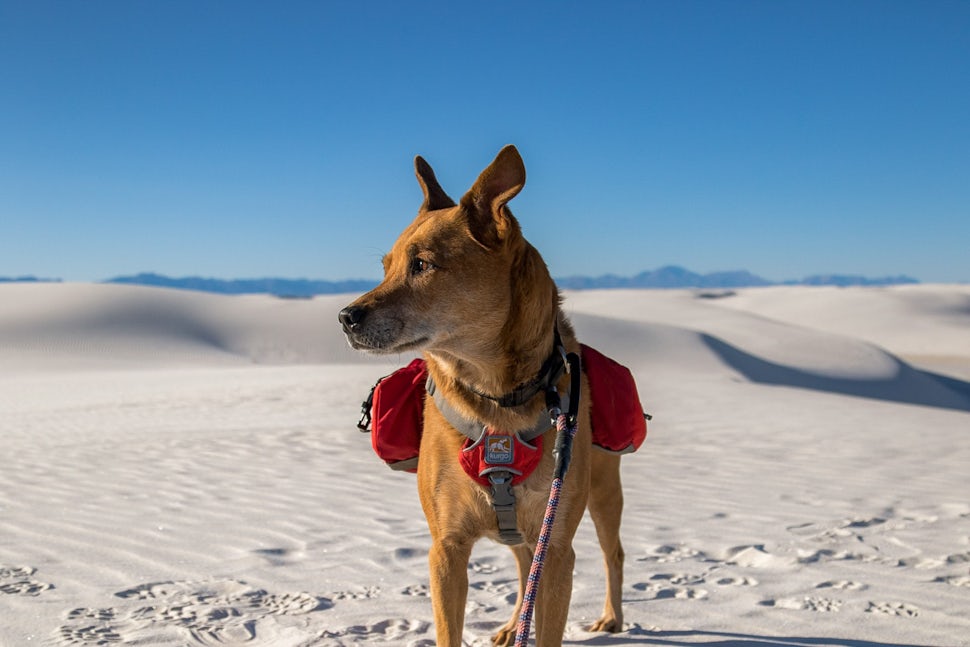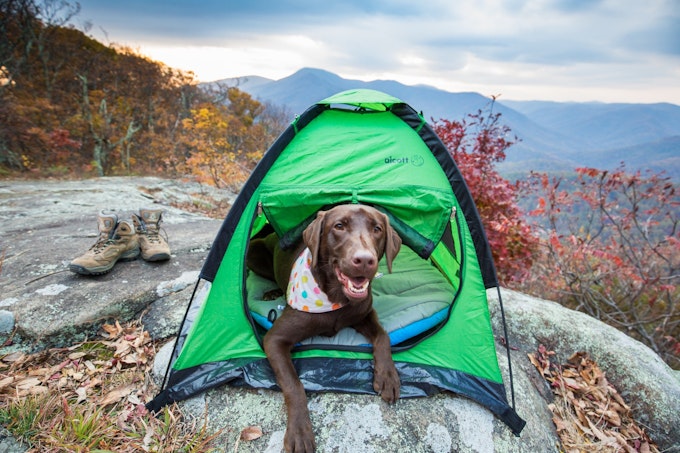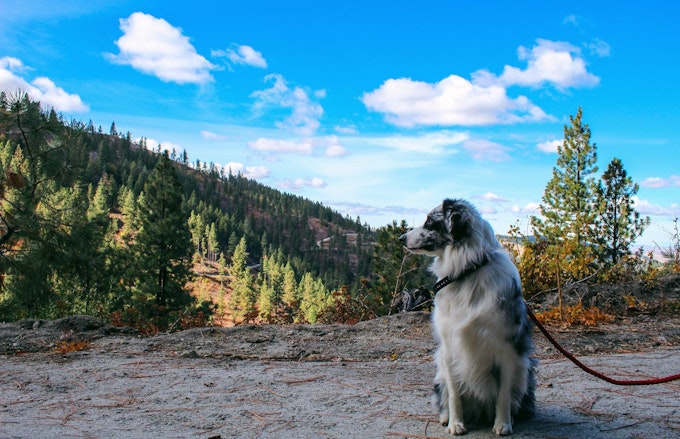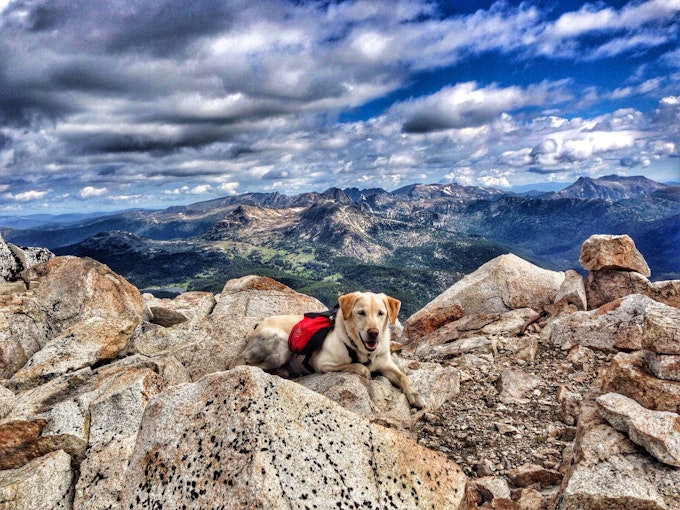Our guide to bringing dogs to national parks
Explore the beauty of a national park with your best fur friend by your side.

Our dogs are more than just pets. They’re family and it can be hard to leave them behind. Thankfully, a lot of national parks welcome dogs with open arms. However, there are rules and regulations and each park is different.
If you're planning a national park adventure and aren’t sure if your dog should tag along, here are some tips and suggestions to help you make the best decision possible for you and your pup.
What to bring
First things first: Prepare all necessary supplies ahead of time to keep your pup happy and comfortable outdoors.
Some important things to remember to pack:
- Dog food and water
- Tether/long leash and stake
- First aid kit: some essential items for your dog include gauze, non-stick bandages, adhesive tape, antibiotic ointment and wipes, scissors, tweezers, hydrogen peroxide, and treats
- Poop bags
- Towels: this can be a great way of drying off your dog or lining a tent so your pup is not tracking in a mess after a long day of getting dirty.
- Dog booties: high temperatures and rough, rocky terrain can take a toll on your dog’s paws. To mitigate injury, it may be a good idea to cover your dog’s feet with booties. Research ahead of time to figure out if your dog’s pads will be okay on the park’s terrain. (Pro tip: Have your dog wear the booties at home for short periods to practice so they're familiar with wearing footwear before you hit the trail.)
Camping with your pet

Photo by: Christin Healey
Most national parks allow pets in established campgrounds. There are a few essentials to keep in mind before bringing them along.
- Dogs have to stay on a leash at all times in park campground.
- Make sure your dog is in good health and up-to-date on vaccinations before bringing them to the park.
- Dogs should always wear a collar with a tag engraved with your current contact information in case they get loose.
Hiking tips
There are a lot of national parks that have restrictions on which trails dogs are allowed to traverse. Check in with the park ahead of time to see if there are pet-friendly trails. Often, gravel and dirt paths are off-limits for canines, while paved trails are more likely to be dog-friendly.
While hiking, be mindful of how busy the park can get. You know your pet better than anyone. If new environments are overwhelming for your pup, it may be best to not take them on highly trafficked routes. Here, you are also likely to encounter other dogs. Work with your pup on socializing and passing others in tight spaces before visiting a national park. This simple prep can make your time in the park less stressful and more enjoyable.
The B.A.R.K. Principles
The National Park Service has created a basic acronym that can apply in all park settings. When visiting parks and monuments with your pup, make sure to follow these simple principles.
Bag your pet’s waste
If your dog poops in the park, make sure you are prepared to pack it out in a doggie bag. Disposing of waste properly is essential to keeping the parks clean. This Leave No Trace principle also helps mitigate the risk of animals consuming the waste as it may carry bacteria or viruses that can negatively impact park wildlife.
Always leash your pet

Photo by: Jenna Cooper
While it is nice to give your pet a little more freedom to explore in campgrounds and on less-busy trails, dogs are required to always be on-leash for the safety and comfort of wildlife and other park visitors. Most parks have a 6-foot leash policy, but check in with the park you will be visiting ahead of time so you can come prepared.
Respect wildlife
While new animals are bound to bring your dog excitement, it is best to keep them a safe distance away from wildlife. Wildlife can easily get spooked ,which could result in the injury of the animal, you, or your dog.
It is also a good idea to get your dog up-to-date on vaccinations before arriving at the park to reduce the possibility of spreading disease to the natural species that dwell in the park. If your dog is sick, the park service encourages you to leave them at home to help protect the wildlife.
Know where you can go
A lot of parks have restrictions surrounding where dogs can go. It is common for the parks to only allow dogs on paved roads or a select number of trails. This rule protects native plant life and keeps wildlife from getting scared. Remember to look up specific dog regulations before visiting national parks. People who do not follow national park regulations can face thousands of dollars of citations or fines.
There are two island-based national parks that do not allow pets: Isle Royale National Park in Michigan and Channel Islands National Park in California. If you want to go to these parks, you will need alternative care for your pups at home.
Some national parks are more dog friendly than others. They provide greater access to trails your dogs can hike, pet-friendly campgrounds, and even nearby boarding opportunities if you want to keep your dog close but not in the park.
If you are determined to bring your dog on all your national park adventures, here are a few great pet-friendly options for you and your pup to visit:
- Acadia National Park, Maine
- Shenandoah National Park, Virginia
- Petrified Forest National Park, Arizona
- New River Gorge National Park and Preserve, West Virginia
- White Sands National Park, New Mexico
- Cuyahoga Valley National Park, Ohio
- Wrangell–St. Elias National Park and Preserve, Alaska
- Congaree National Park, South Carolina
- Yosemite National Park, California
- Indiana Dunes National Park, Indiana
- Great Sand Dunes National Park and Preserve, Colorado
- Zion National Park, Utah

Photo by: John Sunich
Note: National Park pet restrictions typically do not apply to service dogs, which are legally permitted anywhere visitors can go. There are restrictions about what qualifies as a service dog, however, so do your research to ensure you will have the support needed from your service dog during your stay.
Dog-friendly adventures
Kayak Cedar Creek at Congaree National Park
Hike the Bubbles Divide Trail to Bubble Rock in Acadia National Park
Backpack the Painted Desert in Petrified Forest National Park
Camp at White Sands National Park
Cover photo by: Halie West
We want to acknowledge and thank the past, present, and future generations of all Native Nations and Indigenous Peoples whose ancestral lands we travel, explore, and play on. Always practice Leave No Trace ethics on your adventures and follow local regulations. Please explore responsibly!
Do you love the outdoors?
Yep, us too. That's why we send you the best local adventures, stories, and expert advice, right to your inbox.








